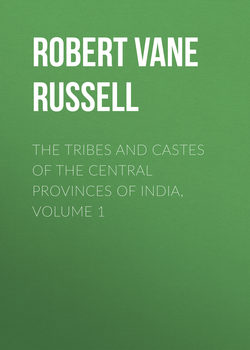Читать книгу The Tribes and Castes of the Central Provinces of India, Volume 1 - Robert Vane Russell - Страница 48
Part I.
Introductory Essay on Caste
Introductory Essay on Caste
45. Subcastes. local type
ОглавлениеAll important castes are divided into a number of subordinate groups or subcastes, which as a rule marry and take food within their own circle only. Certain differences of status frequently exist among the subcastes of the occupational or social type, but these are usually too minute to be recognised by outsiders. The most common type of subcaste is the local, named after the tract of country in which the members reside or whence they are supposed to have come. Thus the name Kanaujia from the town of Kanauj on the Ganges, famous in ancient Indian history, is borne by subcastes of many castes which have immigrated from northern India. Jaiswār, from the old town of Jais in the Rai Bareli District, is almost equally common. Pardeshi or foreign, and Pūrabia or eastern, are also subcaste names for groups coming from northern India or Oudh. Mahobia is a common name derived from the town of Mahoba in Central India, as are Bundeli from Bundelkhand, Narwaria from Narwar and Mārwāri from Mārwār in Rājputāna. Groups belonging to Berār are called Berāri, Warade or Baone; those from Gujarāt are called Lād, the classical term for Gujarāt, or Gujarāti, and other names are Deccani from the Deccan, Nimāri of Nimar, Havelia, the name of the wheat-growing tracts of Jubbulpore and Damoh; Chhattīsgarhia, Kosaria, Ratanpuria (from the old town of Ratanpur in Bilāspur), and Raipuria (from Raipur town), all names for residents in Chhattīsgarh; and so on. Brāhmans are divided into ten main divisions, named after different tracts in the north and south of India where they reside;88 and these are further subdivided, as the Mahārāshtra Brāhmans of the Marātha country of Bombay into the subcastes of Deshasth (belonging to the country) applied to those of the Poona country above the western Ghāts; Karhāra or those of the Satara District, from Karhar town; and Konkonasth or those of the Concan, the Bombay coast; similarly the Kanaujia division of the Pānch-Gaur or northern Brāhmans has as subdivisions the Kanaujia proper, the Jijhotia from Jajhoti, the old name of the Lalitpur and Saugor tract, which is part of Bundelkhand; the Sarwaria or those dwelling round the river Sarju in the United Provinces; the Mathuria from Muttra; and the Prayāgwāls or those of Allahabad (Prayāg), who act as guides and priests to pilgrims who come to bathe in the Ganges at the sacred city. The creation of new local subcastes seems to arise in two ways: when different groups of a caste settle in different tracts of country and are prevented from attending the caste feasts and assemblies, the practice of intermarriage and taking food together gradually ceases, they form separate endogamous groups and for purposes of distinction are named after the territory in which they reside; this is what has happened in the case of Brāhmans and many other castes; and, secondly, when a fresh body of a caste arrives and settles in a tract where some of its members already reside, they do not amalgamate with the latter group, but form a fresh one and are named after the territory from which they have come, as in the case of such names as Pardeshi, Pūrabia, Gangapāri (‘from the other side of the Ganges’), and similar ones already cited. In former times, when the difficulties of communication were great, these local subcastes readily multiplied; thus the Kanaujia Brāhmans of Chhattīsgarh are looked down upon by those of Saugor and Damoh, as Chhattīsgarh has been for centuries a backward tract cut off from the rest of India, and they may be suspected of having intermarried with the local people or otherwise derogated from the standard of strict Hinduism. Similarly the Kanaujia Brāhmans of Bengal are split into several local subcastes named after tracts in Bengal, who marry among themselves and neither with other Kanaujias of Bengal nor with those of northern India. Since the opening of railways people can travel long distances to marriage and other ceremonies, and the tendency to form new subcastes is somewhat checked; a native gentleman said to me, when speaking of his people, that when a few families of Khedāwāl Brāhmans from Gujarāt first settled in Damoh they had the greatest difficulty in arranging their marriages; they could not marry with their caste-fellows in Gujarāt because their sons and daughters could not establish themselves, that is, could not prove their identity as Khedāwāl Brāhmans; but since the railway has been opened intermarriage takes place freely with other Khedāwāls in Gujarāt and Benāres. Proposals are on foot to authorise the intermarriage of the three great subcastes of Marātha Brāhmans: Deshasth, Konkonasth and Karhāra. As a rule, there is no difference of status between the different local subcastes, and a man’s subcaste is often not known except to his own caste-fellows. But occasionally a certain derogatory sense may be conveyed; in several castes of the Central Provinces there is a subcaste called Jharia or jungly, a term applied to the oldest residents, who are considered to have lapsed in a comparatively new and barbarous country from the orthodox practices of Hinduism. The subcaste called Deshi, or ‘belonging to the country,’ sometimes has the same signification. The large majority of subcastes are of the local or territorial type.
88
See article on Brāhman.
